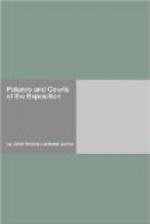1915
The Panama Canal is opened to the commerce of the world.
-
The United States has put thru the canal, so the American eagle with outstretched wings is seen as a decorative motive on either side of the Tower — with telling suggestions.
The hand of the law is governing the commerce of the Panama Canal, hence you receive that gentle reminder in the Roman insignia, the fasces.
In the old Roman days of the kingdom, as well as in the days of the Roman republic, the lictor marched in front of the head of the State carrying the fasces, those twelve birch rods with the ax, indicating punishment and then death if the laws were not obeyed.
The fasces are seen at the extreme ends of the wings of the tower.
It is interesting to see this same device used in the Liberal Arts Palace and in the Educational Palace — especially in reform exhibits or such exhibitions as the New York Educational Exhibit, where the hand of state is suggested.
The laurel wreath on the tower is another speaking motive.
The vessels push out in all directions from the Panama Canal. You get that suggestion at the corners of the third lift.
Don’t lose sight of the beautiful turquoise green columns in the temple forms of the Tower. At night the aquamarines follow out the same beautiful color.
Watch, when the Tower is first illuminated with the blood glow, and you will see that it almost pulsates with life. It should, for is it not the vital part of this great Exposition?
-
Jewels on the Tower
There are some ten tons of jewels used at the Exposition.
Fifty thousand jewels are used on the Tower alone, accenting in the main its architectural feature.
These jewels are of live colors — mostly canary and white glass, ruby, emerald, aquamarine.
Mathematical calculations have been made by expert physicists to show at just what angle the jewel must be cut.
These jewels were made in Austria.
Nearly every village in Austria has its glass workers — the finest workers in their line in the world.
Sand of a peculiar quality is most carefully prepared, mixed with other ingredients, the whole being brought to a molten state.
This glass is then poured into molds.
It is taken out of the molds, the casts being carefully
trimmed by hand.
The principal tool used is a rotating sanded wheel.
The prism is polished by hand with tin, so as to make the facets perfectly smooth. This glass must be very hard in order to reflect sufficiently well.
The glass is called Sumatra Stone. It is tinted to counterfeit jewels. These jewels are held in place by metallic bands from which extend small arms at the back of each jewel to hold tiny mirrors which assist in the reflection.
Each jewel is suspended from a hook so that it is in constant vibration, in order to catch the rays of light most advantageously.




